|
|
|
Sort Order |
|
|
|
Items / Page
|
|
|
|
|
|
|
| Srl | Item |
| 1 |
ID:
144932
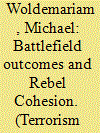

|
|
|
|
|
| Summary/Abstract |
This article uses data from the Eritrean war for independence to refine existing theories of rebel fragmentation. The author argues organizational performance affects the emergence of factional infighting within rebel organizations in unique and novel ways. While battlefield losses increase the likelihood of internal fragmentation, so do battlefield gains. The implication is battlefield stalemates possess unique properties that promote organizational cohesion in war, a relationship this study refers to as “cohesive stalemates.” The article extends an emerging literature on the internal politics of insurgent groups that has linked the coherence of rebel organizations to rebel losses.
|
|
|
|
|
|
|
|
|
|
|
|
|
|
|
|
| 2 |
ID:
144928


|
|
|
|
|
| Summary/Abstract |
Pakistan has a long history of patronizing militant proxies, and in recent years it has become a victim as well as a supporter of terrorism. The evolution of the jihadist insurgency in Pakistan's Federally-Administered Tribal Areas (FATA) and neighboring Khyber Pakhtunkhwa, the Pashtun militants leading it, efforts to counter the insurgency, and the overall strategic threats to the state have merited significant study. With some notable exceptions, less attention has been paid to the role Punjabi militant organizations and their splinters have played in bringing the insurgency to Pakistan's heartland. The involvement of these actors in the revolutionary jihad against the state gives the FATA-based actors leading this insurgency power projection capabilities throughout the country. This article helps to fill that knowledge gap by bringing a more detailed level of analysis to the understanding of how anti-state Punjabi militant networks function at the macro-, meso-, and micro-levels. In doing so, it illustrates that the introduction of new loci of jihad at the macro-level, simultaneous integration and atomization among militant groups at the meso-level, and greater portability of fighters at the micro-level impedes covert control by Pakistani intelligence services and decreases the utility of even sincere counterterrorism efforts by the Pakistani state.
|
|
|
|
|
|
|
|
|
|
|
|
|
|
|
|
| 3 |
ID:
144926
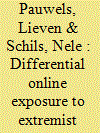

|
|
|
|
|
| Summary/Abstract |
The present study applies Social Learning (Differential Association) Theory to the explanation of political violence, focusing on exposure to extremist content through new social media (NSM) and controlling for key variables derived from rival theories. Data are gathered using (a) a paper-and-pencil study among high school students, and (b) a web survey targeting youths between 16 and 24 years old. A total of 6020 respondents form the dataset. Binary logistic regression is used to analyze the data. Results show that even when controlling for background variables, strain variables, personality characteristics, moral values, and peer influences, the statistical association between measures of extremism through NSM (ENSM) and self-reported political violence remains significant and fairly constant. The most persistent effects are found for those measures where individuals actively seek out extremist content on the Internet, as opposed to passive and accidental encounters using NSM. Furthermore, offline differential associations with racist and delinquent peers are also strongly and directly related to self-reported political violence, as are some mechanisms from rival perspectives. This indicates that political violence can only partially be explained by social learning and suggests that the impact of ENSM is mediated by real-world associations and that the offline world has to be taken into account.
|
|
|
|
|
|
|
|
|
|
|
|
|
|
|
|
| 4 |
ID:
144929
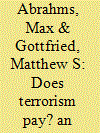

|
|
|
|
|
| Summary/Abstract |
Does terrorism help perpetrators to achieve their demands? Few research questions about terrorism generate as much controversy. This study contributes to the debate in two main ways. First, we identify major limitations within the burgeoning literature on the effectiveness of terrorism. Specifically, we highlight the main methodological problems vexing empirical assessments of whether terrorism promotes government concessions. Second, we present a research design that circumvents those recurrent methodological shortcomings. In short, we find no empirical evidence to suggest that terrorism pays. In fact, multiple variants of the tactic in hostage standoffs impede the perpetrators from coercing government compliance. The negative effect of terrorism on the odds of compliance is significant and substantial across logistic and multilevel logistic model specifications, particularly when civilians are killed or wounded in the coercive incident. These findings have important implications for both scholars and practitioners of counterterrorism.
|
|
|
|
|
|
|
|
|
|
|
|
|
|
|
|
| 5 |
ID:
144919
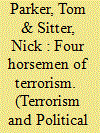

|
|
|
|
|
| Summary/Abstract |
David Rapoport's concept of Four Waves of terrorism, from Anarchist terrorism in the 1880s, through Nationalist and Marxist waves in the early and mid-twentieth century, to the present Religious Wave, is one of the most influential concepts in terrorism studies. However, this article argues that thinking about different types of terrorism as strains rather than waves better reflects both the empirical reality and the idea that terrorists learn from and emulate each other. Whereas the notion of waves suggests distinct iterations of terrorist violence driven by successive broad historical trends, the concept of strains and contagion emphasizes how terrorist groups draw on both contemporary and historical lessons in the development of their tactics, strategies, and goals. The authors identify four distinct strains in total—Socialist, Nationalist, Religious, and Exclusionist—and contend that it is possible to trace each strain back to a “patient zero” active in the 1850s.
|
|
|
|
|
|
|
|
|
|
|
|
|
|
|
|
| 6 |
ID:
144921
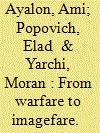

|
|
|
|
|
| Summary/Abstract |
Conflicts in the 21st century differ from past conflicts based on two central factors: the level of asymmetry and disparity between the actors taking part in the conflict and the amount of foreign media coverage that a conflict receives. This article aims to develop a new theoretical perspective on the implications of these two factors on how the involved states manage a conflict. Most actors in current conflicts have vast levels of disparity and receive extensive media coverage; events in those conflicts are referred to as occurrences in the “information space” because a conflict's borders are anywhere people can receive information about it. “Imagefare”—the use of images as a guiding principle or a substitute for traditional military means to achieve political objectives—is argued to be the main tool for better facing adversaries in the information space.
|
|
|
|
|
|
|
|
|
|
|
|
|
|
|
|
| 7 |
ID:
144924
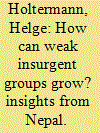

|
|
|
|
|
| Summary/Abstract |
How can insurgent groups that are militarily far weaker than the state survive and grow? Influential accounts drawing on Kalyvas' “control-collaboration” model argue that limited state reach can make this possible by allowing rebel groups to carve out pockets of control where they can elicit collaboration. I suggest that this account is inadequate. Even states with limited reach are likely to transfer sufficient forces to rebel-affected areas to establish at least partial control. Weak rebels therefore often face the challenge of building capacity without local control to begin with. I identify two broad factors that can make this feasible: first, strong pre-existing rebel networks, which facilitate collaboration through solidarity, norms of reciprocity, and social incentives; and second, counterinsurgency policies and practices that fail to exploit the opportunities that control offers for incentivizing collaboration and shaping political preferences. These arguments are grounded in a fieldwork-based case study of insurgency processes in a hamlet of Rolpa, Nepal.
|
|
|
|
|
|
|
|
|
|
|
|
|
|
|
|
| 8 |
ID:
144923
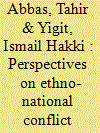

|
|
|
|
|
| Summary/Abstract |
This article reports the findings of an ethnographic study of families with members involved in the armed struggle for Kurdish nationalism led by the Kurdistan Workers' Party. Based on in-depth, semi-structured interviews and observations with a theoretical sample of six families in the area of Yüksekova, detailed discussions were held with twelve members of families with children, partners, or siblings involved in the conflict. Ethno-national exceptionalism plays a significant role in determining the motivations of political violence among groups, but with the additional background of the perceptions and realities of systematic racialization, de-territorialization, disenfranchisement, and cultural exclusion that affect certain Kurdish groups. The findings in this article offer critical sociological and anthropological accounts of the localized drivers of ethno-nationalism, and the motivations for and the experiences of conflict among families with members involved in the armed conflict and the “Kurdish question” in Turkey.
|
|
|
|
|
|
|
|
|
|
|
|
|
|
|
|
| 9 |
ID:
144933
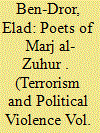

|
|
|
|
|
| Summary/Abstract |
In December 1992, after the kidnapping and murder of a policeman, Israel deported 415 members of Hamas and Islamic Jihad to Lebanon. Most were affiliated with the Hamas political apparatus and had not been involved in terrorism. The deportees decided to stay together and set up a camp in Marj al-Zuhur in southern Lebanon. Here they engaged in study and various cultural pursuits—including poetry writing. Roughly a dozen of the deportees wrote poetry. The poems were read aloud at gatherings in the camp and published in the Arab press. Their main function was to raise the residents’ spirits and keep their plight in the public eye. They incorporate the expected political messages: anger at Israel and criticism of the international community, the Palestinian leadership, and the Arab states, which were prodded to work harder for the deportees’ return. The poetry was part of a successful media and information campaign, which annoyed Israel so much that it allowed all the deportees to return home by December 1993. Some of the poems were later published and helped cultivate the myth of the Marj al-Zuhur deportation, which Hamas viewed as a victory and symbol of steadfast resistance to Israel.
|
|
|
|
|
|
|
|
|
|
|
|
|
|
|
|
| 10 |
ID:
144930
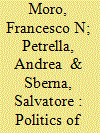

|
|
|
|
|
| Summary/Abstract |
Violence perpetrated by organized crime nowadays represents a major threat to state stability, both because it directly challenges political institutions, targeting officials and using terrorist techniques, and because severe inter-group conflict strongly affects human security. Though it is a distinctive feature of illegal markets and a constant strategy of Mafia-like groups, the occurrence of violence is localized in time and space. The article aims to explain temporal and spatial variation in Mafia killings focusing on its political determinants, as organized crime is deeply embedded in the political system. The analysis shows that there is a clear link between the structure of the political markets and the severity of violence. In particular, the fragmentation of the political market is negatively associated with the strategy of criminal groups to exploit violence. By contrast, single-party dominance and bipartisanship lead to an increase in homicides since these organizations have few opportunities to access the political arena. Outcomes are assessed through the analysis of monthly homicides reported by police forces in Italian provinces from 1983 to 2008.
|
|
|
|
|
|
|
|
|
|
|
|
|
|
|
|
| 11 |
ID:
144931


|
|
|
|
|
| Summary/Abstract |
Does more representative government improve states' ability to fight domestic terrorism? In prior work, democracies are seen as more susceptible to terrorism because their respect for human rights prevents them from fully eliminating terrorist groups. However, such extrajudicial aggression could also alienate large portions of the population and create the ideal conditions for an insurgency. I argue that since terrorism is the lowest-capacity form of political violence, it is natural that states that do best at deterring political violence experience the most terrorism. While representative democracies should see terrorist groups initiate spells of attacks at a greater frequency, full political representation should also galvanize major political actors to unite and eliminate terrorist threats. I test this assertion through statistical models that treat the process of terrorist group initiation and its duration and intensity separately. Results not only show that less consolidated democracies and autocracies experience longer and more intense terrorist campaigns, but that, in support of the theory's mechanisms, groups are more likely to shift to terrorism from insurgency when their political base gains more political representation. The results call the division among research programs of various political violence types into question.
|
|
|
|
|
|
|
|
|
|
|
|
|
|
|
|
| 12 |
ID:
144927
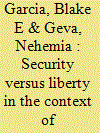

|
|
|
|
|
| Summary/Abstract |
A critical question in counterterrorism studies concerns the extent to which governments adequately balance the continual provision of individual rights and freedoms with the appropriate level of national security when faced with a terrorist attack. We experimentally assess this tradeoff utilizing a 2 × 2 × 2 between-groups factorial design, manipulating (a) the extent of terror-related threats, (b) the level of invasiveness of subsequent counterterrorism policies, as well as (c) the terror context: transnational and domestic. The results provide evidence that the public is more willing to accept greater reductions in civil liberties under a greater threat of terrorism only when the perceived effectiveness of those policies to prevent future acts of terrorism is high. Furthermore, we find these results to be specific to the context of a transnational terror threat. This suggests that the public will be unwilling to accept reductions in civil liberties when the source of the attack is domestic, regardless of the level of threat or how effective subsequent policies may be in preventing future attacks.
|
|
|
|
|
|
|
|
|
|
|
|
|
|
|
|
| 13 |
ID:
144920


|
|
|
|
|
| Summary/Abstract |
Academic studies of terrorism and mass political violence have developed largely independently of one another. Insurgents, in contrast, have tended to incorporate terrorism tactics along with other types of unconventional warfare in their repertoire of action. This tendency has become more apparent among insurgents engaging in armed confrontations in the twenty-first century. In order to take account of this development, scholars and others interested in contemporary warfare need to incorporate terrorism studies within the broader subject of insurgencies and “small wars”—political violence, in other words.
|
|
|
|
|
|
|
|
|
|
|
|
|
|
|
|
| 14 |
ID:
144925
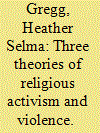

|
|
|
|
|
| Summary/Abstract |
Numerous scholars have investigated religiously motivated violence, particularly in the wake of September 11, including discussions on the role of modernity in triggering religious violence, the increasing presence of religion in politics, the violence-prone nature of certain religions, and religion's correlation with ethnicity and other conflict-intensifying variables. However, religious activism and violence are not new phenomena. Few theories have been advanced that move across time and space and, broadly, seek to explain the conditions under which religion becomes involved in activism and violence. This article argues that three broad causal arguments for religious activism—social movements, fundamentalism, and apocalyptic warriors—help explain the conditions under which religiously motivated violence occurs across time and space. These three causal arguments offer a spectrum of goals within religious activism, ranging from challenging social practices and government policies, to defending specific interpretations and practices of the faith, to hastening the apocalypse. Furthermore, each of these theories proposes different ways that religion becomes involved in social, political, and religious activism and the conditions under which groups use violence to further their goals. The article concludes by suggesting countermeasures for each type of religious activism.
|
|
|
|
|
|
|
|
|
|
|
|
|
|
|
|
| 15 |
ID:
144922
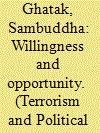

|
|
|
|
|
| Summary/Abstract |
Domestic terrorism, as a form of intrastate violence, has varied widely in South Asia along with the post-Cold War period of global economic integration and political openness. How are these two phenomena—economic integration and emergence of democracies—related to domestic terrorism in South Asia? I argue that resorting to terrorism is a rational choice when individuals'/groups' cost of heterogeneity—deprivation from public goods due to geographical and ideological distance—increases; opportunity is provided by democratization and integration into the global economy. The testable hypotheses derived from the theory are empirically tested on a dataset of five South Asian countries for the time period between 1990 and 2007. The results show that both minority discrimination and presence of unconsolidated democratic institutions increase terrorism in the highly heterogeneous South Asian countries. International trade in the presence of minority discrimination increases homegrown terrorism, but foreign direct investment neither increases nor decreases such incidents.
|
|
|
|
|
|
|
|
|
|
|
|
|
|
|
|
|
|
|
|
|